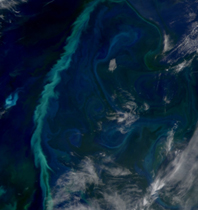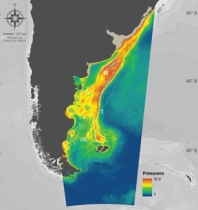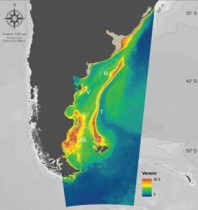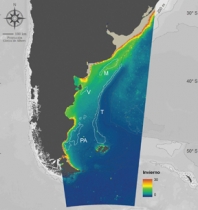|
 |
 | Continental slope, one of the oceanic areas where phytoplankton production is higher. Satellite image.  |
 |
Productivity and Ocean Fronts in Spring. Concentration of chlorophyll-a in mg/m3. Ocean fronts: slope (T), mid-shelf (M), Valdés (V) and Patagonia Austral (PA).
Data obtained from SeaWiFS (Code 970-2) and Distributed Active Archive Center (Code 902), Goddard Space Flight Center, NASA. Contributed by M. Carranza, S. Romero and A. Piola (SHN–UBA–CONICET, Argentina). Synthesis of the Conservation Status of the Patagonian Sea and Areas of Influence (2008).
| © SeaWiFS Project, NASA |
 |
Chlorophyll-a (Spring) |
 Chlorophyll-a (Summer) Chlorophyll-a (Summer) |
Productivity and Ocean Fronts in Summer. Concentration of chlorophyll-a in mg/m3. Ocean fronts: slope (T), mid-shelf (M), Valdés (V) and Patagonia Austral (PA).
Data obtained from SeaWiFS (Code 970-2) and Distributed Active Archive Center (Code 902), Goddard Space Flight Center, NASA. Contributed by M. Carranza, S. Romero and A. Piola (SHN–UBA–CONICET, Argentina). Synthesis of the Conservation Status of the Patagonian Sea and Areas of Influence (2008).
 |  Clorofila-a (Autumn) Clorofila-a (Autumn) |
Productivity and Ocean Fronts in Autumn. Concentration of chlorophyll-a in mg/m3. Ocean fronts: slope (T), mid-shelf (M), Valdés (V) and Patagonia Austral (PA).
Data obtained from SeaWiFS (Code 970-2) and Distributed Active Archive Center (Code 902), Goddard Space Flight Center, NASA. Contributed by M. Carranza, S. Romero and A. Piola (SHN–UBA–CONICET, Argentina). Synthesis of the Conservation Status of the Patagonian Sea and Areas of Influence (2008).
 Clorofila-a (Winter) Clorofila-a (Winter) |
Productivity and Ocean Fronts in Winter. Concentration of chlorophyll-a in mg/m3. Ocean fronts: slope (T), mid-shelf (M), Valdés (V) and Patagonia Austral (PA).
Data obtained from SeaWiFS (Code 970-2) and Distributed Active Archive Center (Code 902), Goddard Space Flight Center, NASA. Contributed by M. Carranza, S. Romero and A. Piola (SHN–UBA–CONICET, Argentina). Synthesis of the Conservation Status of the Patagonian Sea and Areas of Influence (2008).
 | |
|
 |
Productivity
Colour satellite images of the ocean can be used to calculate the concentration of chlorophyll-a in phytoplankton and the level of oceanic productivity. The Patagonian Sea is a highly productive environment with approximately three times greater abundance of phytoplankton than the mean recorded for the world’s ocean. Phytoplankton is not distributed homogeneously but there is greater concentration in areas associated with ocean fronts. Chlorophyll concentrations undergo seasonal variations. However, the location of the fronts is predictable over time and stable in space, due to the fact that they are closely linked to features of the seabed. Ocean fronts reveal maximum productivity values during the spring and summer, especially on the slope (T), mid-shelf (M), Valdés (V) and Patagonia Austral (PA) fronts.
|

